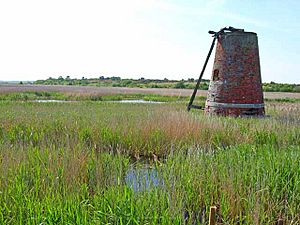Suffolk Coast National Nature Reserve facts for kids
Quick facts for kids
Designations
|
|
| Official name: Minsmere - Walberswick | |
| Designated: | 5 January 1976 |
|---|---|
| Reference #: | 75 |
The Suffolk Coast National Nature Reserve is a very special place for wildlife. It is located on the North Sea coast in Suffolk, England. This large nature reserve is found near the village of Walberswick. It is also south of the town of Southwold.
The reserve was created in 2003. It brought together the older Walberswick National Nature Reserve. It also included reserves at Dingle Marshes and Hen Reedbeds. This made one big reserve that is about 1,340 hectares (or 3,311 acres) in size.
Many groups work together to look after this amazing reserve. These include Natural England, the RSPB, and Suffolk Wildlife Trust. The Dingle Marshes area is owned by the RSPB and Suffolk Wildlife Trust together. The Hen Reedbeds area belongs to Suffolk Wildlife Trust. Most of the Walberswick marshes are privately owned. Natural England helps manage these parts.
The reserve is part of a larger protected area. This area is called the Minsmere–Walberswick Heaths and Marshes Site of Special Scientific Interest. It also includes areas that are important for wildlife around the world. These are known as Natura 2000 sites and Ramsar sites.
Contents
A Look Back in Time: History of the Reserve
The marshland areas of the reserve have an interesting past. Between the 1500s and 1700s, people drained these marshes. They turned them into farmland for grazing animals.
During the Second World War, the marshes south of Walberswick were flooded. This was done to help defend against a possible invasion. You can still find old military buildings, like pillboxes, in the reserve today. After the war, in the 1940s and 1950s, the marshes returned to being reedbeds. This created many different places for wildlife to live.
Today, these reedbeds are protected. Local people still cut the reeds. They use them for thatching roofs. Some marshland areas are still used for cattle grazing.
The heathland parts of the reserve were once used for grazing sheep. Rabbits also helped keep these areas open. But in 1953, a disease called Myxomatosis affected many rabbits. After this, much of the heathland started to turn into birch woodland. Now, people manage the heathland. They remove trees and bring sheep back to graze. This helps keep the heathland looking as it traditionally did.
Amazing Habitats and Wildlife
The Walberswick part of the reserve is the biggest. It covers about 1,192 hectares (or 2,945 acres). This area has many different types of habitats. You can find reedbeds, hay meadows, and grazing marshes. There are also heathlands with heather and grass. Plus, there are woodlands with different kinds of trees.
Along the coast, you will find shingle banks and beaches. There are also salty lagoons and areas where the river meets the sea. These places offer fresh, salty, and slightly salty water habitats. Near the Blyth estuary, there are mudflats and more grazing marsh.
Insects and Other Small Creatures
The reserve is home to around 500 different kinds of butterflies and moths. These include the beautiful silver-studded blue and white admiral butterflies. You can also find other amazing insects here. These include solitary bees and wasps, as well as ant-lions. There are also over 100 types of cranefly.
Birds and Mammals
About 300 different bird species live or visit the reserve. Some of these include bitterns and marsh harriers. Mammals you might spot include otters and five different kinds of deer. The Natterjack toad has also been brought back to live in this area.
Wonderful Plants
The reserve has many interesting plants. In the wet areas, you might see plants like marsh sowthistle and bog pimpernel. Other wetland plants include sneezewort and greater bladderwort. The heathland areas have plants like fenugreek and mossy stonecrop.
Special Areas: Hen Reedbeds and Dingle Marshes
Hen Reedbeds has a mix of reedbeds, small channels (dykes), pools, and fen habitats. Dingle Marshes has both coastal and freshwater wetland habitats. This includes pools with slightly salty water. Both of these areas are very important breeding grounds for bitterns and marsh harriers. Dingle Marshes is also a globally important place for the starlet sea anemone.
Visiting the Reserve: Facilities
The reserve has several things to make your visit enjoyable. There are car parks where you can leave your vehicle. You will also find marked walking paths to explore. You can even download three audio trails to listen to as you walk. Three permanent bird hides are also set up in the reserve. These are great places to watch birds without disturbing them.



